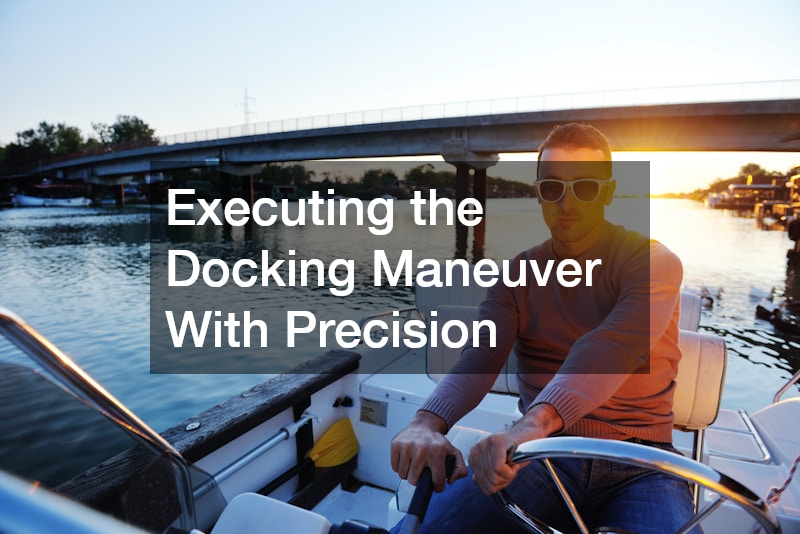
Docking a boat can be one of the trickiest maneuvers a boater faces, especially when it comes to boat docks in Ft Lauderdale, FL. Familiarize yourself with your boat’s dimensions, handling characteristics, and features that are crucial to successful docking, such as thrusters and steering sensitivity. Understanding these aspects allows you to anticipate the boat’s movements and make necessary adjustments.
Environmental elements like wind, current, and tide can also heavily influence the process. Therefore, having a solid understanding of how your boat reacts under different conditions is essential to mastering the art of docking.
Before heading out, ensure your boat’s docking equipment is in good working order. Inspect the ropes, fenders, and bumpers to make sure they are free from wear and damage, as these play a vital role in safely bringing the boat to a stop. Maintaining communication with your crew is vital to coordinating the docking process, especially at busy boat docks in Ft Lauderdale, FL. Assign roles to each crew member and establish clear signals to avoid any confusion. As you near the dock, reduce speed to allow time for adjustments, keeping the vessel under control.
Awareness of the surrounding area is crucial; consult local maps and marina charts to predict potential challenges at your docking destination. Ft Lauderdale’s waterways can be particularly active, with traffic and complex layouts to navigate through. Tides and weather conditions can change rapidly, so always check forecasts and prepare for contingencies. Use binoculars to identify docks from a distance and plan your approach accordingly. A calm and calculated approach enhances safety and fosters confidence in handling the vessel in varying conditions.
Executing the Docking Maneuver with Precision
Approaching the dock with precision is critical for a smooth docking experience. Begin by aligning the boat parallel to the dock, keeping an eye on the wind direction to anticipate potential drift. Use short bursts on the throttle to avoid excessive speed, maintaining control and the ability to make quick direction changes if necessary. As you get closer to the dock, utilize forward and reverse gears to gently nudge the vessel into place. Remember, slow and steady maneuvers are the safest way to ensure a successful docking.
Communication with marina staff or fellow boaters can also be invaluable when docking, providing insights into current conditions and assistance if needed. Many boat docks in Ft Lauderdale, FL, have personnel available to help guide your vessel into its berth. This coordination can significantly mitigate risks and make the process less stressful. Always remain attentive and adaptive to the conditions in real-time, adjusting your strategy as circumstances dictate. Flexibility and readiness to respond to changes are key to docking success.
Once close to the dock, make use of fenders to prevent any damage from contact between the boat and the dock. These protective buffers absorb the kinetic energy, preventing scratches and dents on both the vessel and the dock. Secure the vessel using appropriate knots, ensuring the lines are taut but not overly restrictive. It is important to leave enough slack to accommodate potential tidal changes and movement. Double check that all lines are fastened securely and that the boat remains stable post-docking.
Securing and Final Checks Post-Docking
After successfully docking, it’s essential to properly secure the vessel. Begin by tying the bow, stern, and spring lines, which will stabilize the boat against bumps from passing water traffic. In FT Lauderdale, with its busy waterways, having your lines set properly can make the difference between a peaceful mooring and a hazardous situation. Inspect the tension of each line, ensuring they prevent excessive movement while allowing for tidal variations.
Conduct a thorough check of all systems on board, verifying that hatches and windows are secure, and that the engine is switched off. This comprehensive check helps prevent unauthorized access and ensures that the vessel isn’t draining unnecessary power while docked. Also, inspect for any collisions or damage that might have occurred during the approach or docking process. Engaging with fellow boaters and dockmasters can be a good source of knowledge, offering tips and best practices from their experiences at boat docks in Ft Lauderdale, FL.
Finally, take a moment to confirm that all safety equipment is in order and ready to use for the next voyage. This includes life jackets, fire extinguishers, and first aid kits, which should be accessible and in good working condition. Keeping safety equipment up-to-date is paramount, ensuring preparedness for any emergencies. Preparing the boat for the next adventure maintains the vessel’s seaworthiness and boosts confidence in your boating abilities. Reviewing these steps post-docking helps reinforce good practices and enhances overall boating safety and efficiency.
Mastering the art of docking at boat docks takes practice, patience, and attention to detail. By understanding your boat’s handling, accounting for environmental factors, maintaining clear communication, and performing thorough post-docking checks, you set yourself up for a safe and smooth experience every time. Docking is not just about bringing the vessel to a stop—it’s about protecting your investment, safeguarding your crew, and navigating the waterways with confidence. Following these guidelines consistently will help you approach each docking maneuver with skill and peace of mind, making every outing on Ft Lauderdale’s waters more enjoyable and secure.




